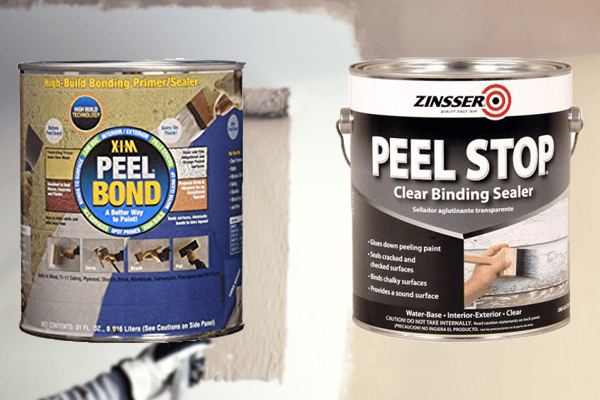Ever faced nasty cracks or peels on your painted walls? Well, you aren’t new. A wall finishing agent or primer may just do the trick for you, preventing such problems.
Peel bond and peel stop are the two most unique wall primers that can smoothen out such problems.
Now comes the hard part. Which one should you choose between Peel bond Vs. Peel stop?
If flexibility is your key motive, try out the peel bond. On the other hand, you can use peel stop to reduce the fake wall appearance and make it more alive.
Don’t worry about rough edges on walls, as both of them are smooth and can fill up nooks and crannies effectively.
Here, we have included a comparison chart between these two wall finishes so that you don’t need to read everything. We have a lot to cover. Let’s get started.

Contents
Peel Bond Vs Peel Stop: Comparison chart
| Features | Peel bond | Peel stop |
| Finish of wall painting | Smooth | Smooth |
| Resulting allergic reaction | Yes | No |
| Requires removal of flaky walls | No | Yes |
| Letting moisture out from wall | Yes | No |
| Requires preparation before applying | Yes | No |
| Letting walls to breathe | No | Yes |
| Best for | Flexibility | Lively appearance of walls |
What you’ve been missing
How to Remove Mold from Painted Walls
3/8 Vs 1/2 Nap Roller
Epoxy Vs. Enamel Paint
Peel Bond: Why choose it?
A peel bond primer seals and bonds construction materials to perfection. It reduces peelings and crackings that usually occur in painted walls. To have a more descriptive idea about peel bonds, give a look below:
Flexible with all paints
One of the most significant features of peel bonds is its flexibility on all paints. As a result, this sticking property will not result in peelings or crackings, which may occur due to paints.
Requires less time to use
While using a peel bond, there will be no need to remove the flaky surfaces of the wall as it is already flexible. Thus, we can save time on mixing by directly applying the sticking property to our walls.
Best to cover cracks
Don’t stress that you haven’t peeled the flaky surfaces of the wall before applying a peel bond. This wall finish not only does the job but also covers all cracks of a flaky wall as well.
Peel Stop: Why choose it?
A peel stop mainly penetrates bonds to the substrate by giving a chalky residue. In the same way, it penetrates into walls’ cracks and below peeling paint edges with the peeling paint. Now let us have a look at its key features:
Smooth finish
Undoubtedly, a peel stop provides a smooth finish of paintings on the wall. This type of finish is hard to remove from walls as it binds all the holes and cracks.
Stops peelings from walls
The peel stops sticking, let the moisture go out of the wall. Thus, it stops walls from peeling and maintains a lively texture of surfaces.
Stays in a pristine condition for many days
The peel stop remains in a pristine condition for many days. This is why the peel stop allows walls to breathe and look more lively than ever. Now, you don’t have to rely on sticky products ever again.
Peel Bond Vs Peel Stop: Head to head comparisons
Till now, we got to know what the peel bond and the peel stop are. If a peel bond is superior in flexibility, the peel stop makes the wall more alive. There are tons more. Let us see what those comparisons are:
Letting walls breathe (Peel stop wins)
The peel bond primer doesn’t let the walls breathe and thus fails to give a lively look to them. Then again, peel stop doesn’t do that, which boosts up the natural look of the walls.
Quicker processing (Peel bond wins)
The peel bond solution is much faster than peel stop. It works flawlessly without the removal of flaky walls. On the other hand, a peel stop primer is a bit time-consuming to work with. While applying a peel stop, first you need to remove the flaky walls. So make sure you have enough time to do the process.
Convenient to use (Peel stop wins)
As the peel bond requires some preparations before using, you may find it complicated to use. If you want a smoother process to apply a paint primer, go for a peel stop. There will be no need to make any preparations prior while using it.
Well mixture (Peel stop wins)
One bad thing about the peel bond is, it does not mix well with the previous paints of walls. As a result, you may not get a flawless look. Well, peel stop is not like that. It gives a smooth finish by mixing with the existing paints of walls.
FAQs
Can I sand peel bonds?
You can sand peel bonds by following a simple process, i.e. dry and recoat. First of all, dry to touch within 30 minutes and apply an alkyd topcoat or latex after 2 hours of drying your peel bound. Again, wait for 4 hours before you are going to type the coat with two-part epoxies. Peel Bond usually does not get my harmful effect even if you sand it after 4 hours.
How to apply a peel stop?
In order to apply a peel stop, use an airless sprayer, a roller, or a roll. A roll or a back brush is highly suitable to put a peel stop into the edges of your old paint or cracks. If the application of your peel stop is proper, that would help to make it dry in dry sheens. Sometimes dry spots are apparent in walls which may not go without a second coat of peel stop. So just apply a second coat whenever you see such dull dry spots.
Can I use a peel stop on a deck?
It would be better if you don’t use a peel stop on a deck. Not only decks, using a peel stop on the surfaces that are engaged with water for a long time are not good to have an appliance of peel stop. However, increasing the dry time is possible by a lowered temperature or decreased humidity.
Is a peel bond primer good enough?
A peel bond primer does really create a difference while painting walls. There are some surfaces that may not get stuck with paint. At that time, a peel bond primer will help you to stick your paints to that surface by prevailing a topcoat layer on it. Alongside, a peel bond will give a better adhesion by penetrating masonry and bare woods of surfaces.
End Note
A peel bond primer does a great job to cover wall cracks. Whereas a peel stop maintains a pristine condition to make the walls look beautiful. So none of them is going to be a bad option for you.
Those who have allergic reactions should be using the peel bond primer as it gives an appearance of flaky walls. However, if you want a flexible paint primer, a peel bond won’t be half bad.
Peel stop makes the walls better and gives a premium look to it. The walls can breadth better and will last longer.
Overall, it’s up to you on which one to choose. This is all for today. Have a good day.
